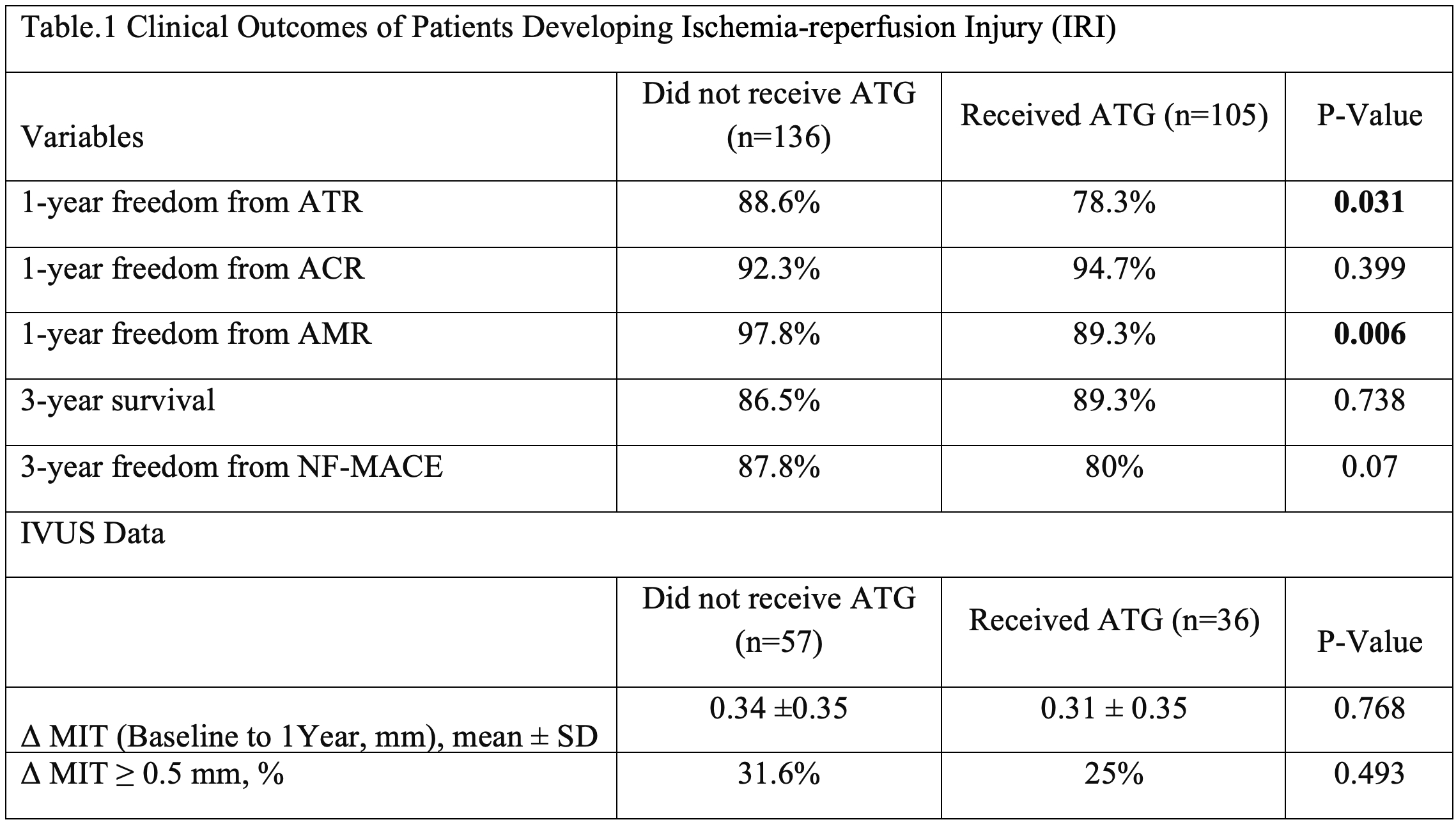Final ID: MDP255
Does Induction Therapy with Anti-thymocyte Globulin Decrease First-year Intimal Thickening in Patients Experiencing Ischemia-Reperfusion Injury Immediately after Heart Transplantation?
Abstract Body (Do not enter title and authors here): Introduction: Post-heart Transplant (HTx) ischemia-reperfusion injury (IRI) is associated with an increased risk of rejection and cardiac allograft vasculopathy (CAV). It has been suggested that induction therapy with anti-thymocyte globulin (ATG) may protect against immediate (in the first 30 days) IRI post-HTx. Additionally, ATG has been associated with reduced first-year coronary plaque progression as assessed by intravascular ultrasound (IVUS) among HTx recipients. Whether ATG can decrease first-year intimal thickening in patients experiencing IRI has not been investigated. Therefore, we aim to examine the clinical outcomes of patients who received ATG induction therapy and experienced immediate IRI post-HTx.
Methods: Between 2010 and 2020, we assessed 241 patients undergoing HTx and were noted to have immediate post-HTx IRI on their endomyocardial biopsy. Patients were divided into those who received ATG (n=105) induction therapy vs. non-receivers (n=136). In our program, ATG is given to sensitized patients or those with baseline serum creatinine >2.0 mg/dL to delay the initiation of tacrolimus, which may introduce bias to this study. Endpoints included 1-year freedom from any treated rejection (ATR), acute cellular rejection (ACR, grade 2R or 3R), and antibody-mediated rejection (AMR, pAMR grade ≥1, 3-year survival, and 3-year freedom from non-fatal major adverse cardiac events (NF-MACE, including myocardial infarction, new congestive heart failure, percutaneous coronary intervention, implantable cardioverter defibrillator/pacemaker implant, and stroke). IVUS was performed at 4-8 weeks (baseline) and at 1 year post-HTx. Studied IVUS parameters included first-year average change in maximum initial thickness (MIT) and change in MIT ≥0.5mm.
Results: Among patients with immediate post-HTx IRI, patients who received ATG induction therapy (57% were sensitized pre-HTx) remained at high immunological risk at 1 year with significantly lower freedom from ATR and AMR but had similar 3-year survival as compared to those who did not receive ATG (Table 1). No between-group differences were observed in the average 1-year change in MIT or the percentage of patients with ≥0.5mm change in MIT.
Conclusion: Induction therapy with ATG did not appear to decrease first-year intimal thickening in patients experiencing IRI immediately post-HTx. Future studies are warranted to mitigate immunological complications and reduce coronary plaque progression in high-risk HTx patients.
Methods: Between 2010 and 2020, we assessed 241 patients undergoing HTx and were noted to have immediate post-HTx IRI on their endomyocardial biopsy. Patients were divided into those who received ATG (n=105) induction therapy vs. non-receivers (n=136). In our program, ATG is given to sensitized patients or those with baseline serum creatinine >2.0 mg/dL to delay the initiation of tacrolimus, which may introduce bias to this study. Endpoints included 1-year freedom from any treated rejection (ATR), acute cellular rejection (ACR, grade 2R or 3R), and antibody-mediated rejection (AMR, pAMR grade ≥1, 3-year survival, and 3-year freedom from non-fatal major adverse cardiac events (NF-MACE, including myocardial infarction, new congestive heart failure, percutaneous coronary intervention, implantable cardioverter defibrillator/pacemaker implant, and stroke). IVUS was performed at 4-8 weeks (baseline) and at 1 year post-HTx. Studied IVUS parameters included first-year average change in maximum initial thickness (MIT) and change in MIT ≥0.5mm.
Results: Among patients with immediate post-HTx IRI, patients who received ATG induction therapy (57% were sensitized pre-HTx) remained at high immunological risk at 1 year with significantly lower freedom from ATR and AMR but had similar 3-year survival as compared to those who did not receive ATG (Table 1). No between-group differences were observed in the average 1-year change in MIT or the percentage of patients with ≥0.5mm change in MIT.
Conclusion: Induction therapy with ATG did not appear to decrease first-year intimal thickening in patients experiencing IRI immediately post-HTx. Future studies are warranted to mitigate immunological complications and reduce coronary plaque progression in high-risk HTx patients.
More abstracts on this topic:
BXOS110 for Acute Ischemic Stroke Treatment (BEST): A Multicenter, Double-Blind, Randomized, Placebo-Controlled, Phase 2 Trial
Ding Yarong, Li Shuya, Wang Zhe, Li Zixiao, Meng Xia, Zhao Xingquan, Wang Yongjun, Li Zixiao
Acetylcholine-loaded Nanoparticles Protect Against Myocardial Injury In In Vitro Cardiac Spheroids and In an In Vivo Myocardial Infarction Murine ModelLiu Chung Ming Clara, Patil Runali, Refaat Ahmed, Vettori Laura, Couttas Timothy, Beck Dominik, Wang Xiaowei, Gentile Carmine

